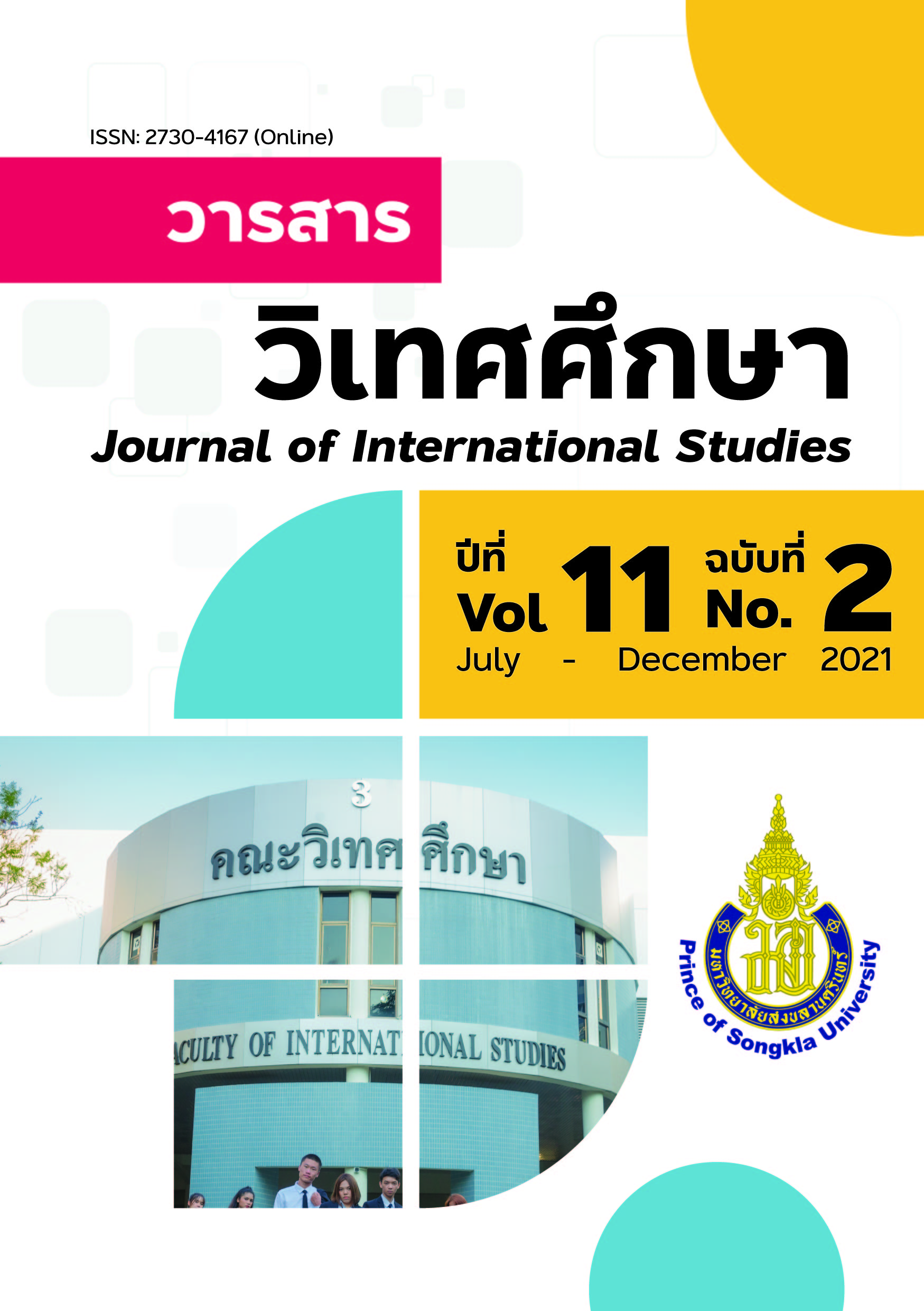The Integration of Innovative Learning Application “Flipgrid” to Encourage Korean Speaking Skills of Faculty of International Studies’ Students, Prince of Songkla University
Main Article Content
Abstract
This paper explores the integration of innovative learning application “Flipgrid” in improving Korean speaking skills of 1st year and 2nd year students of Faculty of International Studies, Prince of Songkla University. The objectives of this study are 1) to examine the level of learners’ satisfaction with the integration of learning application Flipgrid, and 2) to evaluate learners’ progress in Korean speaking after using Flipgrid by measuring from the relative growth rate (RGR). The samples of this study include 8 second-year and third-year students of the International Studies program. This study collects the data through 1) speaking assessment 2) the satisfaction survey and 3) in-depth interview. This study utilizes the statistical analysis method through average, standard deviation, and relative growth rate (RGR). The result of this research reveals that 1) the average satisfaction score of students to practice speaking Korean through Flipgird is 4.67 with being on an extremely satisfying scale. Learning activities through Flipgird increase the roles of learners and engage students with practical learning. Moreover, this activity improves students’ speaking skills at the highest scale. 2) The students have an increased relative growth rate of 55.23 on average at a high scale.
Article Details
Statements and opinions expressed in articles herein are those of the authors and do not necessarily reflect the position of the editors or publisher.
Article, information, text, image, etc. which are published in Journal of International Studies, belong to Journal of International Studies. If anybody or any organization would like to use part or whole of them, they must receive written permission from Journal of International Studies before usage.
References
คัทลียา วิเลปะนะ, และจินตวีร์ คล้ายสังข์. (2562). ผลของการจัดสภาพแวดล้อมการเรียนรู้ภาษาออนไลน์โดยใช้ภาระงานเป็นฐาน เพื่อพัฒนาทักษะการสื่อสารด้วยวาจาสำหรับผู้เรียนที่ใช้ภาษาไทยเป็นภาษาที่สอง. วารสารวิชาการศึกษาศาสตร์ คณะศึกษาศาสตร์ มหาวิทยาลัยศรีนครินทรวิโรฒ, 2(2), 14-26.
ชนสิทธิ์ สิทธิ์สูงเนิน. (2560). ห้องเรียนกลับด้าน: ทักษะการเรียนรู้ในศตวรรษที่ 21. วารสาร มจร สังคมศาสตร์ปริทรรศน์, 6(2), 171-
เนติมา บูรพาศิริวัฒน์. (2563). การศึกษาความต้องการล่ามภาษาเกาหลีของตลาดแรงงานในประเทศไทย: การศึกษาประกาศรับสมัคร
ออนไลน์. วารสารภาษาและวัฒนธรรมเกาหลีศึกษา, 2(1), 153-173.
ประลอง ครุฑน้อย. (2554). เกณฑ์การประเมิน (ฟัง-พูด). ค้นเมื่อ 15 มกราคม 2563, จาก https://www.gotoknow.org/posts
/457798
ปวีณนุช พุ่มจิต, และอังค์วรา เหลืองนภา. (2562). การใช้แอปพลิเคชันในการพัฒนาทักษะภาษาอังกฤษด้านการฟัง. การประชุมวิชาการนำเสนอผลงานวิจัยระดับชาติของนักศึกษาด้านมนุษย์ศาสตร์และสังคมศาสตร์ครั้งที่ 2 (หน้า 550-561). คณะมนุษยศาสตร์และสังคมศาสตร์ มหาวิทยาลัยราชภัฏสวนสุนันทา.
ฟรอคจีเนียส. (2560). Virtual Reality (VR) & Augmented Reality (AR) เทคโนโลยีโลกเสมือนก้าวสู่โลกความเป็นจริง. ค้นเมื่อ 17 มีนาคม2563, จาก https://froggenius.com/news/detail/7/Virtual- Reality--VR----Augmented-Reality--AR
เยาวเรศ ภักดีจิตร. (2557). Active Learning กับการพัฒนาผู้เรียนในศตวรรษที่ 21. นครสวรรค์: สาขาวิชาสังคมศึกษา คณะครุศาสตร์ มหาวิทยาลัยราชภัฏนครสวรรค์.
ศราธรณ์ หมั่นปรุ, และสุภาวดี ในเสนา. (2562). กลวิธีการสอนอย่างมีประสิทธิภาพเพื่อส่งเสริมการฟัง พูดภาษาอังกฤษ ของผู้เรียน
ภาษาอังกฤษเป็นภาษาต่างประเทศ ในศตวรรษที่ 21. วารสารวิชาการเครือข่ายบัณฑิตศึกษา มหาวิทยาลัยราชภัฏภาคเหนือ, 9(2), 1-16.
ศิริชัย กาญจนาวสี. (2538). การวัดการเปลี่ยนแปลง. การประชุมเชิงปฏิบัติการครั้งที่ 3 เรื่อง “หลักและวิธีวิจัยขั้นสูงเฉพาะการวิจัย
และพัฒนาระบบพฤติกรรมไทยด้านต่างๆ” สำนักงานคณะกรรมการวิจัยแห่งชาติร่วมกับคณะกรรมการแห่งชาติเพื่อการวิจัย
และพัฒนาระบบพฤติกรรมไทย (หน้า 144-199). กรุงเทพฯ: สำนักพิมพ์จุฬาลงกรณ์มหาวิทยาลัย.
ศิริพล แสนบุญส่ง. (2563). เทคโนโลยีสำหรับการจัดการเรียนการสอนในยุค 4.0. ค้นเมื่อ 3 ตุลาคม 2563, จาก http://anyflip.com/sdrlp/ vsup/basic
สกล ธีระวรัญญู. (2559). รีวิว Flipgrid. ค้นเมื่อ 22 มีนาคม 2563, จาก https://celt.li.kmutt.ac.th/km/index.php/ba2403zq
xi/
สถาบันออนไลน์ Skilllane. (2563). จาก e-learning สู่ Flipped Classroom. ค้นเมื่อ 19 สิงหาคม 2563, จาก https://www. skilllane.com/blog/elearning-to-flipped-classroom
สุวัฒน์ บรรลือ. (2560). รูปแบบการจัดการเรียนการสอนออนไลน์ที่เหมาะสมสำหรับมหาวิทยาลัยราชภัฏอุบลราชธานี. วารสารมหาวิทยาลัยราชภัฎร้อยเอ็ด, 11(2), 250-260.
แอนเดอสัน, เจ. (2563). เมื่อไวรัสโควิด-19 กำลังพลิกโฉมระบบการศึกษาโลก [The Coronavirus pandemic is reshaping education] (นงลักษณ์ อัจนปัญญา, ผู้แปลและเรียบเรียง) ค้นเมื่อ 8 สิงหาคม 2563, จาก https://www.eef.or.th /30577/
Bartlett, M. (2018). Using Flipgrid to Increase Students' Connectedness in an Online Class. eLearn Magazine,
, 55-61.
Finnachiaro, M. (1964). English as a second language: from Theory to practice. New York: Regent Publish Company.
Jeremy, F. (2011). Flipped Classroom. Flipped Classroom Conference. Ohio State University.
Stoszkowski, J. (2018). Using Flipgrid to develop social learning. Compass Journal of Learning and Teaching, 11(2), Retrieved on March, 17, 2020, from https:// journals.gre.ac.uk/index.php/compass/article /view /786/pdf


